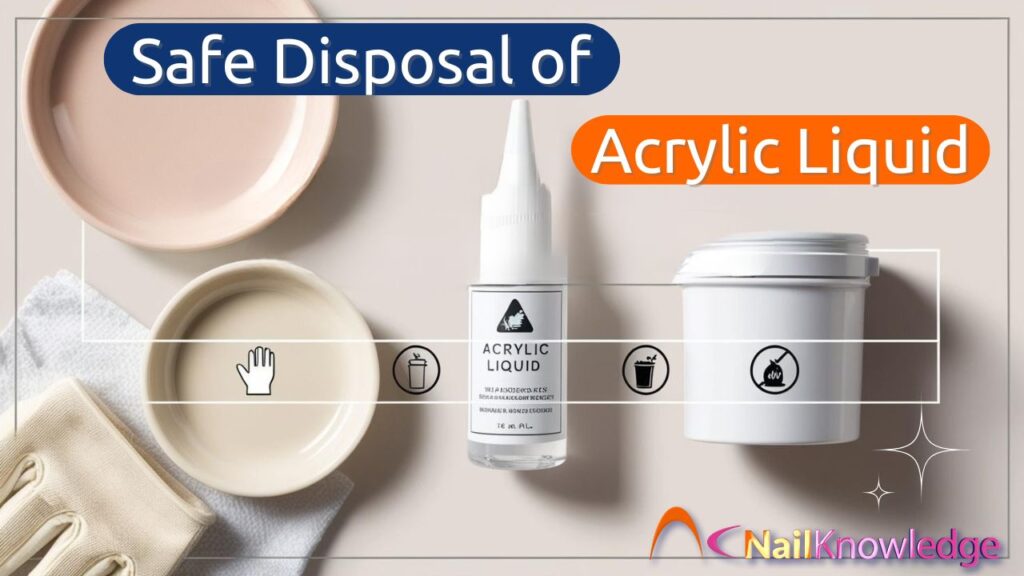There’s something undeniably satisfying about a fresh acrylic nail set, the shine, the shape, the sheer artistry. But once the client leaves and you’re left with your tools, your dappen dish still half-full of liquid monomer, a crucial question arises: how do you manage the xử lý chất lỏng acrylic một cách an toàn và có trách nhiệm?
It might seem like a small thing, pouring out a bit of unused product. But when it comes to acrylic liquid, also known as monomer, improper disposal can be both dangerous and environmentally harmful. Let’s break it down, not just what you nên làm, nhưng Tại sao nó quan trọng.
Hiểu bản chất của chất lỏng Acrylic
First off, it helps to understand what we’re working with. Chất lỏng Acrylic, the monomer in your dappen dish, is a powerful chemical compound. When mixed with bột polyme, it hardens into the durable acrylic nails many of us know and love. But before it cures, that liquid is highly volatile, flammable, and capable of causing irritation or allergic reactions with repeated exposure.
Think of it like paint thinner or nail polish remover—it may be commonplace in your toolkit, but it demands respect. The fumes alone can be irritating to the lungs, and spills can wreak havoc on surfaces. This isn’t the kind of thing you just rinse down the sink or chuck into a regular rubbish bin. So, what do you do?
Cách đúng đắn để xử lý việc thải bỏ chất lỏng Acrylic
Phương pháp an toàn nhất cho xử lý chất lỏng acrylic depends on the amount you’re dealing with. Small amounts left behind after a service can be managed quite easily and safely:
1. Kết hợp với bột Acrylic
If there’s just a little liquid left in your dappen dish, you can mix it with an equal amount of acrylic powder. This causes the monomer to begin curing, turning it into a semi-solid mass that’s far less dangerous than the raw liquid. Once it hardens, this mixture can be tossed in the bin with your regular salon waste. Easy, right?
2. Không bao giờ trộn số lượng lớn
Here’s where it gets risky. Mixing more than 30ml (or about one ounce) of chất lỏng acrylic với bột can generate heat as it cures. We’re not talking mild warmth, we’re talking temperatures that can scorch skin or, in extreme cases, ignite a fire. If you’ve ever felt a nail tip warm up during curing, you’ve already had a glimpse of the chemical reaction at work.
3. Lau sạch và chứa
If you’re not combining with powder, use a disposable paper towel to wipe out any residual liquid from your dappen dish. That towel should be sealed in a plastic bag before throwing it away. Why the extra step? Acrylic liquid evaporates quickly, releasing strong fumes. A sealed bag helps contain those vapours and keeps your bin from smelling like a chemistry lab.
Tại sao việc xử lý đúng cách lại quan trọng
It’s not just about keeping your salon tidy, it’s about protecting your health and the environment. Pouring monomer down the sink or toilet can contaminate water supplies. It’s not something treatment plants are equipped to filter out, and over time, repeated disposal like this can contribute to broader environmental pollution.
From a personal health perspective, repeated skin contact with uncured monomer can lead to irritation, sensitisation, or even long-term allergies. Once someone becomes allergic to a substance like this, they’re often allergic for life, and that can be career-ending in the nail industry.
Việc hít phải khói có thể không gây hại ngay lập tức, nhưng theo thời gian, việc tiếp xúc có thể dẫn đến đau đầu, nausea, and respiratory irritation. That’s why good ventilation is critical, and why proper cleanup is more than just a chore.
Những điều không nên làm
It’s worth being crystal clear here—some disposal methods are simply unsafe. Here’s a quick list of don’ts khi nói đến chất lỏng acrylic:
- Don’t pour it down the sink, toilet, or drain.
- Don’t dump it into outside soil or gutters.
- Don’t burn it or let it evaporate in open air.
- Don’t store used paper towels or soaked wipes in open bins.
If your local waste management facility offers hazardous waste disposal services, that’s an ideal option for any bulk leftover product.
Mẹo để Thực hành Salon An toàn hơn
Làm móng acrylic có thể là một hình thức nghệ thuật, nhưng việc vệ sinh là một khoa học. Sau đây là một số mẹo để giữ cho thói quen của bạn an toàn và bền vững:
- Chỉ sử dụng những gì bạn cần. Giảm thiểu chất thải ngay từ nguồn có nghĩa là bạn sẽ bớt lo lắng về việc xử lý chất thải sau này.
- Đậy nắp hộp đựng. Điều này làm giảm sự bốc hơi và kiểm soát khói.
- Bảo quản chất lỏng ở nơi khô ráo, thoáng mát. Nhiệt độ và ánh sáng có thể làm giảm chất lượng sản phẩm và tăng nguy cơ.
- Đeo găng tay. Mọi lúc. Ngay cả khi dọn dẹp nhanh.
- Thông gió cho không gian của bạn. Luồng khí tốt có thể tạo ra sự khác biệt lớn về chất lượng không khí và sự thoải mái.
Suy nghĩ cuối cùng
Vào cuối ngày, đúng cách xử lý chất lỏng acrylic is part of being a responsible beauty professional. It’s not just about ticking a safety box, it’s about protecting yourself, your clients, and the planet. Acrylics may be small, but the impact of their ingredients can be significant if mishandled.
Vì vậy, lần tới khi bạn nhìn vào vũng nước nhỏ dưới đáy đĩa dappen của mình, hãy nhớ: xử lý nó một cách thông minh. Chỉ cần thêm vài giây cẩn thận có thể cứu bạn khỏi rất nhiều rắc rối sau này.


